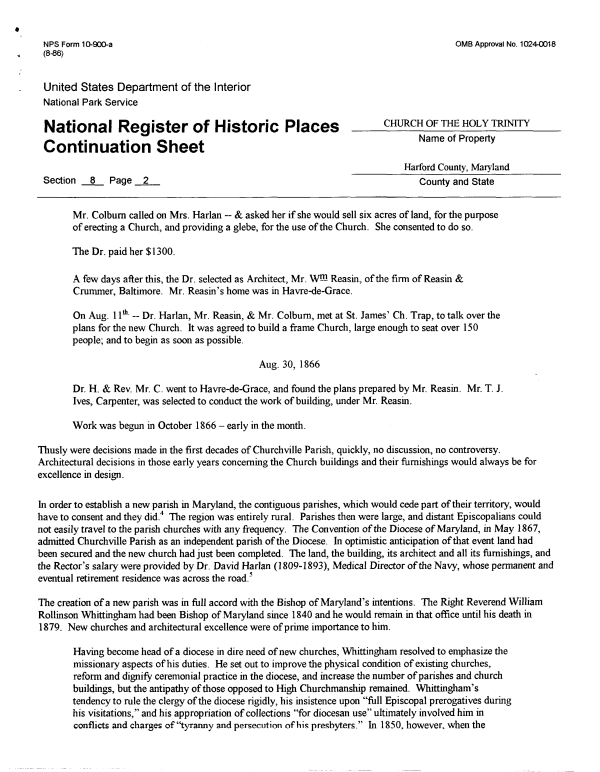 |
||||
|
DEPARTMENT OF HOUSING AND COMMUNITY DEVELOPMENT, MARYLAND HISTORICAL TRUST (Historic Sites Survey) var.d. MSA SE16-8 Image No: se16-8-0356 Enlarge and print image (66K) |
 |
||||
|
DEPARTMENT OF HOUSING AND COMMUNITY DEVELOPMENT, MARYLAND HISTORICAL TRUST (Historic Sites Survey) var.d. MSA SE16-8 Image No: se16-8-0356 Enlarge and print image (66K) |
| NPSForm10-900-a OMB Approval No. 1024-0018 (8-86) United States Department of the Interior National Park Service National Register Of Historic Places CHURCH OF THE HOLY TRINITY f,k .. ,. ~. A Name of Property Continuation Sheet Harford County, Maryland Section 8 Page 2 County and State Mr. Colbum called on Mrs. Harlan — & asked her if she would sell six acres of land, for the purpose of erecting a Church, and providing a glebe, for the use of the Church. She consented to do so. The Dr. paid her $1300. A few days after this, the Dr. selected as Architect, Mr. W"3 Reasin, of the firm of Reasin & Crummer, Baltimore. Mr. Reasin's home was in Havre-de-Grace. On Aug. 11- - Dr. Harlan, Mr. Reasin, & Mr. Colburn, met at St. James' Ch. Trap, to talk over the plans for the new Church. It was agreed to build a frame Church, large enough to seat over 150 people; and to begin as soon as possible. Aug. 30, 1866 Dr. H. & Rev. Mr. C. went to Havre-de-Grace, and found the plans prepared by Mr. Reasin. Mr. T. J. Ives, Carpenter, was selected to conduct the work of building, under Mr. Reasin. Work was begun in October 1866 - early in the month. Thusly were decisions made in the first decades of Churchville Parish, quickly, no discussion, no controversy. Architectural decisions in those early years concerning the Church buildings and their furnishings would always be for excellence in design. In order to establish a new parish in Maryland, the contiguous parishes, which would cede part of their territory, would have to consent and they did.4 The region was entirely rural. Parishes then were large, and distant Episcopalians could not easily travel to the parish churches with any frequency. The Convention of the Diocese of Maryland, in May 1867, admitted Churchville Parish as an independent parish of the Diocese. In optimistic anticipation of that event land had been secured and the new church had just been completed. The land, the building, its architect and all its furnishings, and the Rector's salary were provided by Dr. David Harlan (1809-1893), Medical Director of the Navy, whose permanent and eventual retirement residence was across the road.5 The creation of a new parish was in full accord with the Bishop of Maryland's intentions. The Right Reverend William Rollinson Whittingham had been Bishop of Maryland since 1840 and he would remain in that office until his death in 1879. New churches and architectural excellence were of prime importance to him. Having become head of a diocese in dire need of new churches, Whittingham resolved to emphasize the missionary aspects of his duties. He set out to improve the physical condition of existing churches, reform and dignify ceremonial practice in the diocese, and increase the number of parishes and church buildings, but the antipathy of those opposed to High Churchmanship remained. Whittingham's tendency to rule the clergy of the diocese rigidly, his insistence upon "full Episcopal prerogatives during his visitations," and his appropriation of collections "for diocesan use" ultimately involved him in conflicts and charges of "tyranny and persecution of his presbyters." Li 1850, however, when the |